Folk horror movies are a bit of an odd duck. Based on the folklore of the country from which the movie originates, the genre relies heavily on the unique landscape of its audience’s heritage and history to divvy out the scares. Examples are much more common in Asian horror such as Sadako from The Ring, who comes from a mix of old yurei aesthetic and the Japanese legends of Okiku and Oiwa, but when it comes to English language works, more specifically American, it’s harder to find examples. American folklore is just not that old. So what exactly is specifically ‘American horror’? Things like ghosts and vampires are known worldwide, with each country having its own version, so what does the US provide to the tapestry of monsters?
Well, after much research, this author has compiled what she believes to be a rounded example of American folk horror movies. These are movies that take their cues from history, cryptids, obsessions, religion, and urban legends, all with a unique American twist.
The Witch (2015)
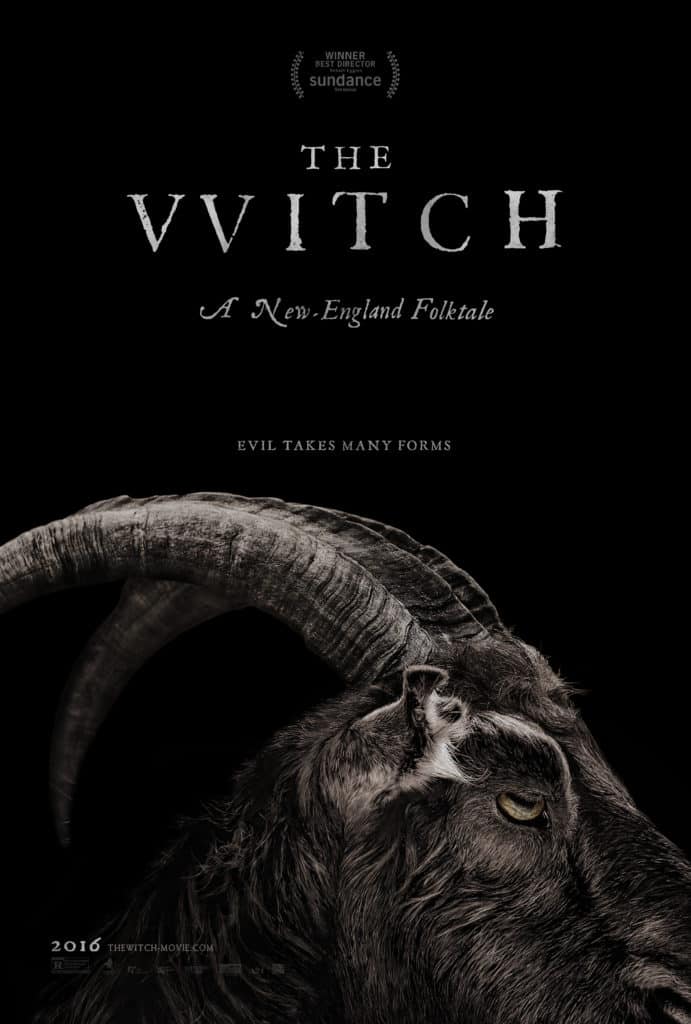 There is nothing more American folklore than the 2015 horror The Witch. Set in the New England of yesteryear, The Witch takes American witch legends and turns them into one of the most successful examples of folk horror in decades. The movie focuses on a Puritan family that is turned away from their village and live a secluded life on the edge of a forest. Unbeknownst to them, the forest is home to a witch and the family’s devout ways are perfect for her to corrupt and booooooy, does she ruin their day. Soon, the cow’s milk turns sour, the crops dry and fail, and the children beginning muttering to a large black goat named Black Phillip. But it’s not until the righteous father is forced to wander in the woods that things start to get really weird…
There is nothing more American folklore than the 2015 horror The Witch. Set in the New England of yesteryear, The Witch takes American witch legends and turns them into one of the most successful examples of folk horror in decades. The movie focuses on a Puritan family that is turned away from their village and live a secluded life on the edge of a forest. Unbeknownst to them, the forest is home to a witch and the family’s devout ways are perfect for her to corrupt and booooooy, does she ruin their day. Soon, the cow’s milk turns sour, the crops dry and fail, and the children beginning muttering to a large black goat named Black Phillip. But it’s not until the righteous father is forced to wander in the woods that things start to get really weird…
The Witch has everything an American folk horror could ask for. Isolation in a new land, an unknown horror stalking them in the woods, the testing of puritanical faith, and the Devil. There have been dozens of articles written examining the movie from a dozen different angles, so I won’t get into any of that, but I will say this is quintessentially American. Witches have been part of the American mindset ever since the Mayflower landed on Plymouth Rock and at the time, they were thought to be a very real threat. Hundreds of people died in the witch trials, and just a mere accusation could make you the next tied to the stake. The Witch takes all those fears and makes them real for the family. If you want to see what Americans actually believed at one point, this is the movie for you.
The Blair Witch Project (1999)
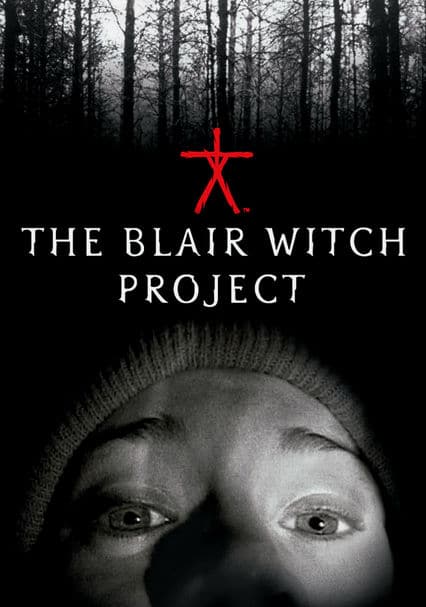 The Blair Witch Project is in the same vein as The Witch, but instead of a historical setting, it’s set in modern day (well 1994) New England. It plays with a lot of the same elements, including isolation in an unknown land and the witch messing with the three leads instead of outright killing them. For a quick recap, this found footage movie is about three college students who explore the legend of Blair Witch in Burkittsville, Maryland. After asking a few locals questions and dicking around with their gear, they soon hit the woods and end up getting lost, all the while being hunted by an invisible monster. Is it the famous Blair Witch, rumored to have cursed anyone who has stepped into the forest, or are they simply losing their minds?
The Blair Witch Project is in the same vein as The Witch, but instead of a historical setting, it’s set in modern day (well 1994) New England. It plays with a lot of the same elements, including isolation in an unknown land and the witch messing with the three leads instead of outright killing them. For a quick recap, this found footage movie is about three college students who explore the legend of Blair Witch in Burkittsville, Maryland. After asking a few locals questions and dicking around with their gear, they soon hit the woods and end up getting lost, all the while being hunted by an invisible monster. Is it the famous Blair Witch, rumored to have cursed anyone who has stepped into the forest, or are they simply losing their minds?
Once again, this is steeped heavily in witch lore and most likely takes its cue from the folktale The Bell Witch, about a witch who curses a family with her dying breath. The movie also focuses on the ‘word-of-mouth’ angle, another staple of American folklore where traditional tales weren’t so much read as told over a camp fire. The Blair Witch Project spawned two sequels which play a bit more with the witch as a mind fuck element, especially the 2000 sequel, though neither quite managed to achieve the success that the first one had. But, despite whatever failures they had, the movies don’t shy away from presenting the true powers once attributed to witches and solidifying The Blair Witch into the folk genre.
Candy Man (1992)
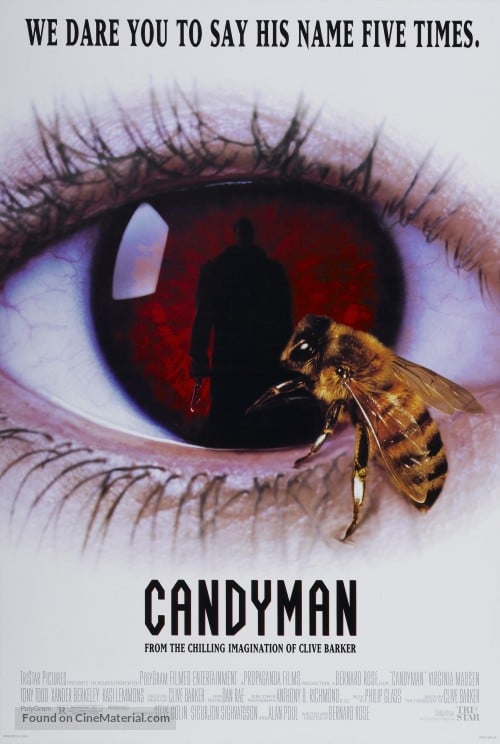 Though originally written by Clive Barker, who is a native Brit, this movie is a solid work of Southern folklore. Candyman touches on American history, with an emphasis on early slavery and urban legends such as Bloody Mary and The Man with a Hook Hand, and mashes them into a hulking figure of revenge. This horror features a woman who is studying urban legends and stumbles on the legend of Candyman, a man with a severed hand who appears to those who say his name five times in front of a mirror before murdering them with his hook hand. While there isn’t a lot of backstory in the first movie, the sequel reveals him to be a slave who fell in love with a white woman and got punished for it by having his hand cut off and covered in honey for bees to attack.
Though originally written by Clive Barker, who is a native Brit, this movie is a solid work of Southern folklore. Candyman touches on American history, with an emphasis on early slavery and urban legends such as Bloody Mary and The Man with a Hook Hand, and mashes them into a hulking figure of revenge. This horror features a woman who is studying urban legends and stumbles on the legend of Candyman, a man with a severed hand who appears to those who say his name five times in front of a mirror before murdering them with his hook hand. While there isn’t a lot of backstory in the first movie, the sequel reveals him to be a slave who fell in love with a white woman and got punished for it by having his hand cut off and covered in honey for bees to attack.
Candyman is a wonderful mix of modern and historical horrors where, while the supernatural angle is a definitely the big draw, it’s more about the evils that people can do to those they feel are inferior. American slavery is a large part of US history and it’s ripe for a horror movie. Urban legends, especially the ones referenced for the character, are another obsession of the American psyche and by blending the two together, makes for a very unique folk horror. In fact, just having a black slave antagonist is an interesting choice. Race relations have always been a hot topic in American culture, even going way back to the founding fathers, so by having the very imposing Tony Todd play a revenge figure, the movie not only bring scares but to make an uncomfortable but important statement about American fear.
Mothman Prophecies (2002)
 If there’s one thing that’s a staple of folk horror the world over its cryptids and America is loaded with them. From Bigfoot in the northwest to the Chupacabra of the South to whatever the hell the Jersey Devil is (it’s Snookie right?), we’re up to our necks in weird monsters. The Mothman Prophecies picks a West Virginia oddity and thrusts Richard Gere into the role of a lifetime! In it, he plays a professor researching the legend of the Mothman, only to learn that those who have seen it have started to hear voices in their head, each connected to a particular tragedy. Though the Mothman monster doesn’t make nearly enough appearances, the movie is based on real events (or real enough) and it’s believed that the Mothman only shows up before a big tragedy.
If there’s one thing that’s a staple of folk horror the world over its cryptids and America is loaded with them. From Bigfoot in the northwest to the Chupacabra of the South to whatever the hell the Jersey Devil is (it’s Snookie right?), we’re up to our necks in weird monsters. The Mothman Prophecies picks a West Virginia oddity and thrusts Richard Gere into the role of a lifetime! In it, he plays a professor researching the legend of the Mothman, only to learn that those who have seen it have started to hear voices in their head, each connected to a particular tragedy. Though the Mothman monster doesn’t make nearly enough appearances, the movie is based on real events (or real enough) and it’s believed that the Mothman only shows up before a big tragedy.
The Mothman Prophecies is not a good movie but it’s based on a good example of an American cryptid as well as the American UFO obsession. The creature, Mothman, is believed to either be an alien being, some kind of supernatural monster, or an unknown animal. It’s also rumored to be followed by the folkloric men in black after every appearance, which all adds up to a monster that exists almost purely on paranoia and the fear of the unknown. He’s another one of those whispered rumors that’s used to keep children in at night, and by tying him to the government or aliens, he becomes wholly original to the American landscape, kind of like Roswell. By the way, if you’re ever in Point Pleasant, West Virginia, check out their statue. Mothman has some abs!
Texas Chainsaw Massacre (1974)
 Texas Chainsaw Massacre is definitely the wild card in the bunch here, but stay with me. TCM is the kind of movie where it’s easy to get lost in the blood and guts and not realize that it’s heavily inspired by the darker side of American folklore: murder. Highwaymen, murderous families, cannibalism, and, of course, the serial killer all figure in the American consciousness. While murderers and cannibals are not a purely an American phenomenon, the US went on to create songs and make stories about them, sometimes even touting the persons as anti-heroes or murderous Robin Hood characters. Americans love crime to the point where criminals have become woven into the fabric of Americana.
Texas Chainsaw Massacre is definitely the wild card in the bunch here, but stay with me. TCM is the kind of movie where it’s easy to get lost in the blood and guts and not realize that it’s heavily inspired by the darker side of American folklore: murder. Highwaymen, murderous families, cannibalism, and, of course, the serial killer all figure in the American consciousness. While murderers and cannibals are not a purely an American phenomenon, the US went on to create songs and make stories about them, sometimes even touting the persons as anti-heroes or murderous Robin Hood characters. Americans love crime to the point where criminals have become woven into the fabric of Americana.
The Texan setting also harks back to the Wild West days of the Gold Rush, where a wrong step could get you robbed or killed. The west is filled with unseen traps, from Indian attacks to wild animals, and the unsuspecting travelers in TCM stumble into something very similar. This movie takes all those fears and makes one of the most successful horror movies of all time. It managed to succeed so well because Tobe Hooper understood the underlying obsession with American killers (particularly Ed Gein) and that we just simply cannot look away. While he ultimately ended up using the movie as an allegory for the state of the world, it’s hard not to feel that tinge of nostalgia when Leatherface slashes up his latest victims.
Get Out (2017)
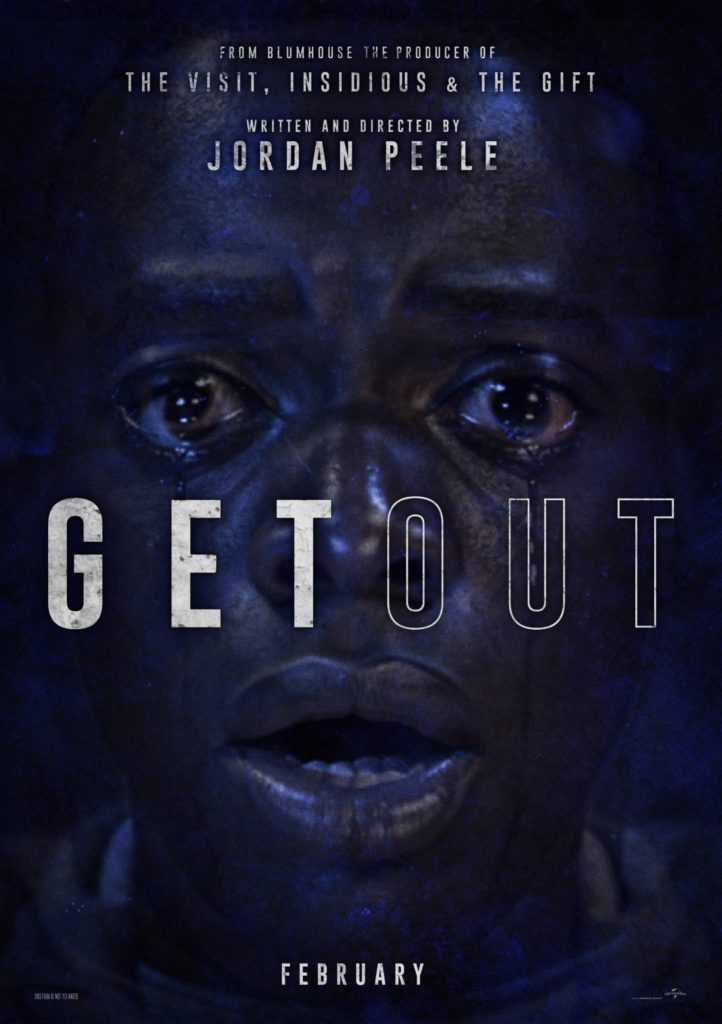 Get Out, much like Candyman, is a layered horror that focuses on Southern folklore and racism, albeit much more modern racism than its predecessor. Yet, unlike Candyman, it goes even deeper into Southern mythology; it goes into voodoo. Okay, maybe not so much voodoo as hypnotism, but the movie clearly draws inspiration from the Afro-Cuban folklore brought over during the slavery years, which tells tales of possessed men via the undead. In Get Out, the black protagonist Chris Washington is invited to spend a weekend at his white girlfriend’s parents’ home, only to feel very out of place. But it’s not just the well-dressed black help that’s putting him on edge, but something much more sinister and the nagging suspicion that he might just be next in line.
Get Out, much like Candyman, is a layered horror that focuses on Southern folklore and racism, albeit much more modern racism than its predecessor. Yet, unlike Candyman, it goes even deeper into Southern mythology; it goes into voodoo. Okay, maybe not so much voodoo as hypnotism, but the movie clearly draws inspiration from the Afro-Cuban folklore brought over during the slavery years, which tells tales of possessed men via the undead. In Get Out, the black protagonist Chris Washington is invited to spend a weekend at his white girlfriend’s parents’ home, only to feel very out of place. But it’s not just the well-dressed black help that’s putting him on edge, but something much more sinister and the nagging suspicion that he might just be next in line.
Get Out touches on a lot of American issues and by addressing them via voodoo horror, the movie re-opens doors that haven’t been opened since, well, Candyman. The film is also set in Alabama, home of rich white folks and abandoned plantations, which create the perfect setting for a work steeped in a slavery allegory. The voodoo folklore serves as the cherry on top and even goes so far as to have that element not used by the black characters but the white ones, making it clear that even a person’s folklore can used be against them and that everything is up for sale.
Red State (2011)
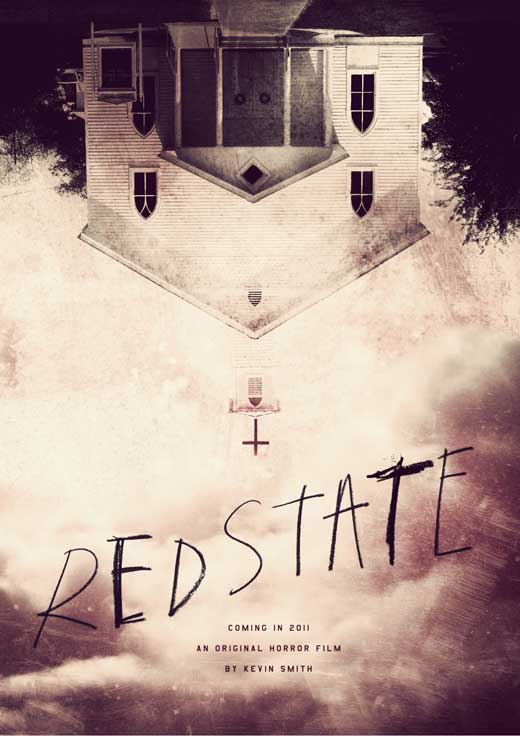 The US has always been a heavily religious country. In fact, that’s why the original settlers left for the new world, so they could find a place where they could pray without the fear of prosecution which haunted them in Europe. Freedom of religion is even a staple of the US Constitution and that freedom has been utilised in a variety of ways for hundreds of years. From holy rollers to traveling bible salesmen, we sure do love our God, in whatever form he may take. Red State is what happens when we love our God too much and have to get the police involved. Harkening back to the real-life cult standoff in Waco, Texas, Red State pulls inspiration from centuries of preachers and the good word and exposes how evil some of it can be.
The US has always been a heavily religious country. In fact, that’s why the original settlers left for the new world, so they could find a place where they could pray without the fear of prosecution which haunted them in Europe. Freedom of religion is even a staple of the US Constitution and that freedom has been utilised in a variety of ways for hundreds of years. From holy rollers to traveling bible salesmen, we sure do love our God, in whatever form he may take. Red State is what happens when we love our God too much and have to get the police involved. Harkening back to the real-life cult standoff in Waco, Texas, Red State pulls inspiration from centuries of preachers and the good word and exposes how evil some of it can be.
As stated, religion, specifically Christianity, has always been a big part of the US. Our Puritanical heritage has woven Jesus into almost every folk story of our culture, so it’s no surprise that movies like Red State can make such an impact. American Christianity has become its own religion and has spawned dozens of branches with some, like Mormonism, deriving exclusively from the US which allows for a uniquely American vision of horror. Red State doesn’t shy away from also focusing on the darker parts of cult Christianity, including homophobia and brain-washing, proving that Jesus is not quite as innocent as the folk songs make him out to be.
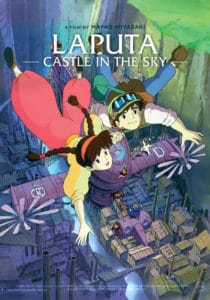
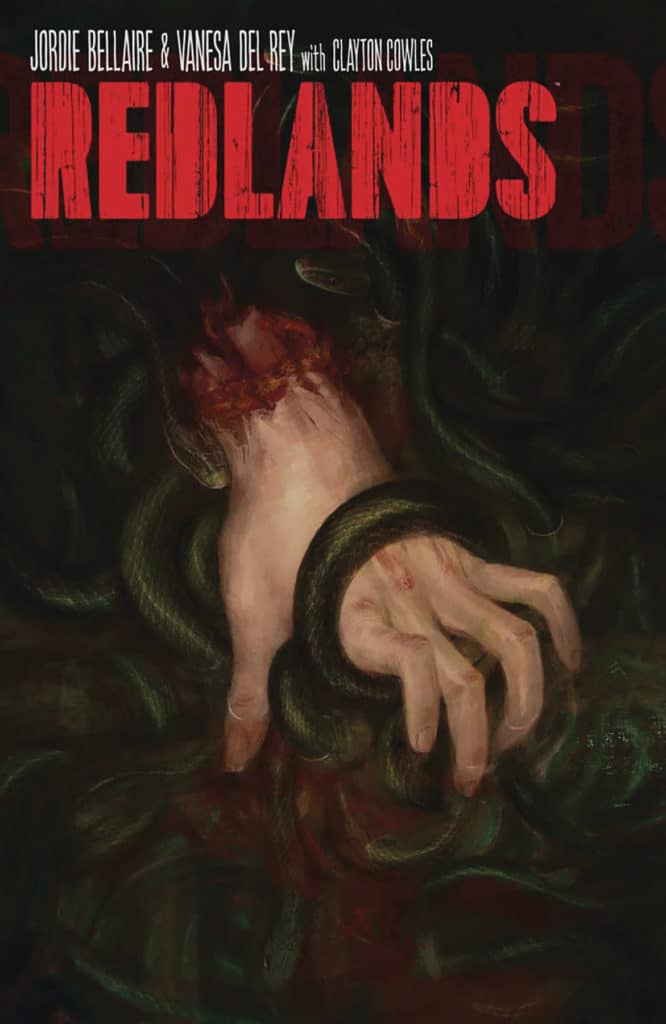 Since Warped Perspective recently celebrated all things folk horror, it’s only appropriate that their own comic reviewer checks out a new addition to the folk horror comic scene, Redlands. Comics and folk horror have gone hand in hand for decades, dating back to early horror anthologies that prominently featured witches, ghouls and the Devil, delivering them into the eager hands of children everywhere. Even now, popular titles such as The Chilling Adventures of Sabrina, Wytches, Harrow County and others keep bringing back that old Puritan terror of evil lurking in the deep dark woods and Image Comics’ Redlands is no exception. A classic gothic tale of witches and madness, the series is as thoroughly creepy as it is original, though the first issue ends a little sooner than I prefer.
Since Warped Perspective recently celebrated all things folk horror, it’s only appropriate that their own comic reviewer checks out a new addition to the folk horror comic scene, Redlands. Comics and folk horror have gone hand in hand for decades, dating back to early horror anthologies that prominently featured witches, ghouls and the Devil, delivering them into the eager hands of children everywhere. Even now, popular titles such as The Chilling Adventures of Sabrina, Wytches, Harrow County and others keep bringing back that old Puritan terror of evil lurking in the deep dark woods and Image Comics’ Redlands is no exception. A classic gothic tale of witches and madness, the series is as thoroughly creepy as it is original, though the first issue ends a little sooner than I prefer. There is nothing more American folklore than the 2015 horror The Witch. Set in the New England of yesteryear, The Witch takes American witch legends and turns them into one of the most successful examples of folk horror in decades. The movie focuses on a Puritan family that is turned away from their village and live a secluded life on the edge of a forest. Unbeknownst to them, the forest is home to a witch and the family’s devout ways are perfect for her to corrupt and booooooy, does she ruin their day. Soon, the cow’s milk turns sour, the crops dry and fail, and the children beginning muttering to a large black goat named Black Phillip. But it’s not until the righteous father is forced to wander in the woods that things start to get really weird…
There is nothing more American folklore than the 2015 horror The Witch. Set in the New England of yesteryear, The Witch takes American witch legends and turns them into one of the most successful examples of folk horror in decades. The movie focuses on a Puritan family that is turned away from their village and live a secluded life on the edge of a forest. Unbeknownst to them, the forest is home to a witch and the family’s devout ways are perfect for her to corrupt and booooooy, does she ruin their day. Soon, the cow’s milk turns sour, the crops dry and fail, and the children beginning muttering to a large black goat named Black Phillip. But it’s not until the righteous father is forced to wander in the woods that things start to get really weird… The Blair Witch Project is in the same vein as The Witch, but instead of a historical setting, it’s set in modern day (well 1994) New England. It plays with a lot of the same elements, including isolation in an unknown land and the witch messing with the three leads instead of outright killing them. For a quick recap, this found footage movie is about three college students who explore the legend of Blair Witch in Burkittsville, Maryland. After asking a few locals questions and dicking around with their gear, they soon hit the woods and end up getting lost, all the while being hunted by an invisible monster. Is it the famous Blair Witch, rumored to have cursed anyone who has stepped into the forest, or are they simply losing their minds?
The Blair Witch Project is in the same vein as The Witch, but instead of a historical setting, it’s set in modern day (well 1994) New England. It plays with a lot of the same elements, including isolation in an unknown land and the witch messing with the three leads instead of outright killing them. For a quick recap, this found footage movie is about three college students who explore the legend of Blair Witch in Burkittsville, Maryland. After asking a few locals questions and dicking around with their gear, they soon hit the woods and end up getting lost, all the while being hunted by an invisible monster. Is it the famous Blair Witch, rumored to have cursed anyone who has stepped into the forest, or are they simply losing their minds? Though originally written by Clive Barker, who is a native Brit, this movie is a solid work of Southern folklore. Candyman touches on American history, with an emphasis on early slavery and urban legends such as Bloody Mary and The Man with a Hook Hand, and mashes them into a hulking figure of revenge. This horror features a woman who is studying urban legends and stumbles on the legend of Candyman, a man with a severed hand who appears to those who say his name five times in front of a mirror before murdering them with his hook hand. While there isn’t a lot of backstory in the first movie, the sequel reveals him to be a slave who fell in love with a white woman and got punished for it by having his hand cut off and covered in honey for bees to attack.
Though originally written by Clive Barker, who is a native Brit, this movie is a solid work of Southern folklore. Candyman touches on American history, with an emphasis on early slavery and urban legends such as Bloody Mary and The Man with a Hook Hand, and mashes them into a hulking figure of revenge. This horror features a woman who is studying urban legends and stumbles on the legend of Candyman, a man with a severed hand who appears to those who say his name five times in front of a mirror before murdering them with his hook hand. While there isn’t a lot of backstory in the first movie, the sequel reveals him to be a slave who fell in love with a white woman and got punished for it by having his hand cut off and covered in honey for bees to attack. If there’s one thing that’s a staple of folk horror the world over its cryptids and America is loaded with them. From Bigfoot in the northwest to the Chupacabra of the South to whatever the hell the Jersey Devil is (it’s Snookie right?), we’re up to our necks in weird monsters. The Mothman Prophecies picks a West Virginia oddity and thrusts Richard Gere into the role of a lifetime! In it, he plays a professor researching the legend of the Mothman, only to learn that those who have seen it have started to hear voices in their head, each connected to a particular tragedy. Though the Mothman monster doesn’t make nearly enough appearances, the movie is based on real events (or real enough) and it’s believed that the Mothman only shows up before a big tragedy.
If there’s one thing that’s a staple of folk horror the world over its cryptids and America is loaded with them. From Bigfoot in the northwest to the Chupacabra of the South to whatever the hell the Jersey Devil is (it’s Snookie right?), we’re up to our necks in weird monsters. The Mothman Prophecies picks a West Virginia oddity and thrusts Richard Gere into the role of a lifetime! In it, he plays a professor researching the legend of the Mothman, only to learn that those who have seen it have started to hear voices in their head, each connected to a particular tragedy. Though the Mothman monster doesn’t make nearly enough appearances, the movie is based on real events (or real enough) and it’s believed that the Mothman only shows up before a big tragedy. Texas Chainsaw Massacre is definitely the wild card in the bunch here, but stay with me. TCM is the kind of movie where it’s easy to get lost in the blood and guts and not realize that it’s heavily inspired by the darker side of American folklore: murder. Highwaymen, murderous families, cannibalism, and, of course, the serial killer all figure in the American consciousness. While murderers and cannibals are not a purely an American phenomenon, the US went on to create songs and make stories about them, sometimes even touting the persons as anti-heroes or murderous Robin Hood characters. Americans love crime to the point where criminals have become woven into the fabric of Americana.
Texas Chainsaw Massacre is definitely the wild card in the bunch here, but stay with me. TCM is the kind of movie where it’s easy to get lost in the blood and guts and not realize that it’s heavily inspired by the darker side of American folklore: murder. Highwaymen, murderous families, cannibalism, and, of course, the serial killer all figure in the American consciousness. While murderers and cannibals are not a purely an American phenomenon, the US went on to create songs and make stories about them, sometimes even touting the persons as anti-heroes or murderous Robin Hood characters. Americans love crime to the point where criminals have become woven into the fabric of Americana. Get Out, much like Candyman, is a layered horror that focuses on Southern folklore and racism, albeit much more modern racism than its predecessor. Yet, unlike Candyman, it goes even deeper into Southern mythology; it goes into voodoo. Okay, maybe not so much voodoo as hypnotism, but the movie clearly draws inspiration from the Afro-Cuban folklore brought over during the slavery years, which tells tales of possessed men via the undead. In Get Out, the black protagonist Chris Washington is invited to spend a weekend at his white girlfriend’s parents’ home, only to feel very out of place. But it’s not just the well-dressed black help that’s putting him on edge, but something much more sinister and the nagging suspicion that he might just be next in line.
Get Out, much like Candyman, is a layered horror that focuses on Southern folklore and racism, albeit much more modern racism than its predecessor. Yet, unlike Candyman, it goes even deeper into Southern mythology; it goes into voodoo. Okay, maybe not so much voodoo as hypnotism, but the movie clearly draws inspiration from the Afro-Cuban folklore brought over during the slavery years, which tells tales of possessed men via the undead. In Get Out, the black protagonist Chris Washington is invited to spend a weekend at his white girlfriend’s parents’ home, only to feel very out of place. But it’s not just the well-dressed black help that’s putting him on edge, but something much more sinister and the nagging suspicion that he might just be next in line. The US has always been a heavily religious country. In fact, that’s why the original settlers left for the new world, so they could find a place where they could pray without the fear of prosecution which haunted them in Europe. Freedom of religion is even a staple of the US Constitution and that freedom has been utilised in a variety of ways for hundreds of years. From holy rollers to traveling bible salesmen, we sure do love our God, in whatever form he may take. Red State is what happens when we love our God too much and have to get the police involved. Harkening back to the real-life cult standoff in Waco, Texas, Red State pulls inspiration from centuries of preachers and the good word and exposes how evil some of it can be.
The US has always been a heavily religious country. In fact, that’s why the original settlers left for the new world, so they could find a place where they could pray without the fear of prosecution which haunted them in Europe. Freedom of religion is even a staple of the US Constitution and that freedom has been utilised in a variety of ways for hundreds of years. From holy rollers to traveling bible salesmen, we sure do love our God, in whatever form he may take. Red State is what happens when we love our God too much and have to get the police involved. Harkening back to the real-life cult standoff in Waco, Texas, Red State pulls inspiration from centuries of preachers and the good word and exposes how evil some of it can be. If you’re not sitting down, I need you to find a seat, and if you are sitting down, I need you to drink some tea so you can spit it out when you hear what I’m about to say. Matt Groening, famously known for Futurama and The Simpsons, has announced a new animated series to be released exclusively through Netflix. That’s right, a new cartoon from the man who brought us such famous memes as “shut-up and take my money” and “to shreds you say?” will be filling your rotating quote wheel with even more catchy one liners!
If you’re not sitting down, I need you to find a seat, and if you are sitting down, I need you to drink some tea so you can spit it out when you hear what I’m about to say. Matt Groening, famously known for Futurama and The Simpsons, has announced a new animated series to be released exclusively through Netflix. That’s right, a new cartoon from the man who brought us such famous memes as “shut-up and take my money” and “to shreds you say?” will be filling your rotating quote wheel with even more catchy one liners! While I truly adored this work, I felt it fell short of having the same punch as Ito’s bigger titles such as Gyo or Uzumaki, or even his other shorter collections like the Tomie translations. Dissolving Classroom, however, does feature a lot of good, solid scares accompanied by his trademark detail work. The melting parts are very detailed and he doesn’t shy away from using smart shading and busy line-work to really make the gross parts pop. It’s very similar to the Garbage Pail Kids-style of art where it’s just the right amount of detail to make you puke in your mouth a little. Both Chizumi and Yuuma are creepy kids, especially Chizumi, who is frequently seen with heavy shadows under her eyes to up the creep ante. Ito definitely has his scares down to an art on this one and with his work on the two leads, he creates a very distinct couple of characters. Also, the Devil is in this and that’s just rad.
While I truly adored this work, I felt it fell short of having the same punch as Ito’s bigger titles such as Gyo or Uzumaki, or even his other shorter collections like the Tomie translations. Dissolving Classroom, however, does feature a lot of good, solid scares accompanied by his trademark detail work. The melting parts are very detailed and he doesn’t shy away from using smart shading and busy line-work to really make the gross parts pop. It’s very similar to the Garbage Pail Kids-style of art where it’s just the right amount of detail to make you puke in your mouth a little. Both Chizumi and Yuuma are creepy kids, especially Chizumi, who is frequently seen with heavy shadows under her eyes to up the creep ante. Ito definitely has his scares down to an art on this one and with his work on the two leads, he creates a very distinct couple of characters. Also, the Devil is in this and that’s just rad.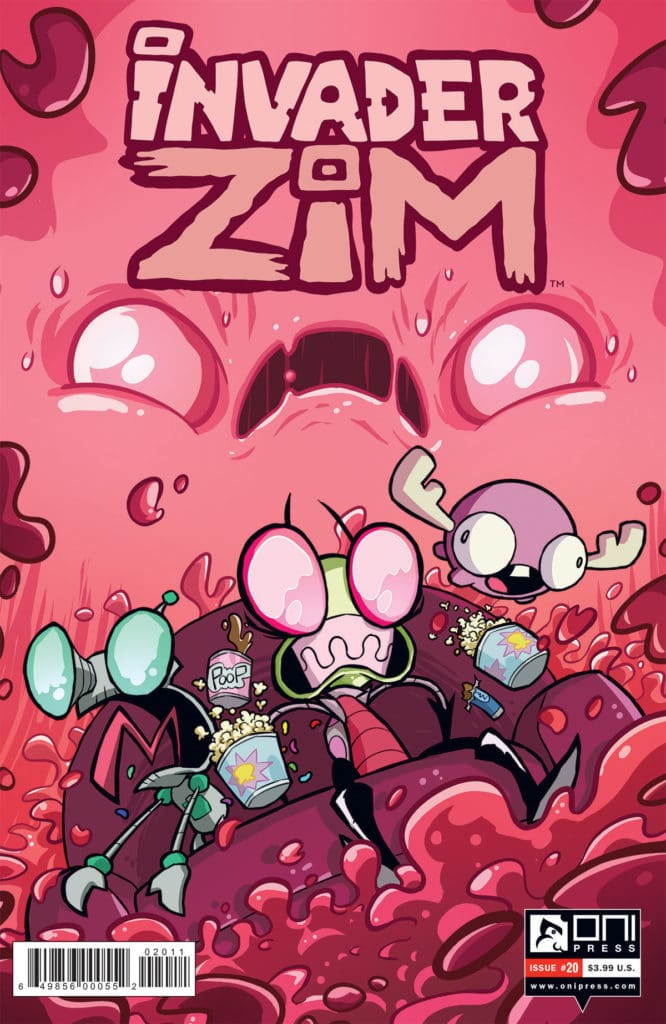 For those of us who were teens in the late 90s to early 2000s and loved Marilyn Manson and JNCO jeans more than life itself, the name Jhonen Vasquez is very familiar. If you didn’t go through puberty like a butterfly of bad fashion, Jhonen Vasquez was the creator of such underground comics as Johnny the Homicidal Maniac, Squee, and I Feel Sick. Along with Roman Dirge and Hot Topic, he was an influential part of the “Spooky Cute” movement and eventually went on to help establish the “lol, so random xD” online subculture that plagues the internet to this day. The latter movement can be partially (okay, mostly) attributed to the short lived animated show Invader Zim. Though the series was canceled after two seasons, its cult status launched the show into television infamy and inspired a comic series of the same name from Oni Press. The comic is generally handled by a revolving collection of writers, which makes issue #40 that much more special. This one is penned by Vasquez himself.
For those of us who were teens in the late 90s to early 2000s and loved Marilyn Manson and JNCO jeans more than life itself, the name Jhonen Vasquez is very familiar. If you didn’t go through puberty like a butterfly of bad fashion, Jhonen Vasquez was the creator of such underground comics as Johnny the Homicidal Maniac, Squee, and I Feel Sick. Along with Roman Dirge and Hot Topic, he was an influential part of the “Spooky Cute” movement and eventually went on to help establish the “lol, so random xD” online subculture that plagues the internet to this day. The latter movement can be partially (okay, mostly) attributed to the short lived animated show Invader Zim. Though the series was canceled after two seasons, its cult status launched the show into television infamy and inspired a comic series of the same name from Oni Press. The comic is generally handled by a revolving collection of writers, which makes issue #40 that much more special. This one is penned by Vasquez himself. Wonder Woman is a lot of things to a lot of people. Superhero, feminist, Amazon, an icon, a killer, and the longest-running female hero to ever grace the pages of comic books. She was the reason a lot of girls started reading comics, and a lot of boys learned that girls can kick ass and take names. She is exactly what her name is, a wonder of a woman, a genre-breaking character that proved that you, yes YOU, can do anything! And yet, despite having been around for over 75 years, it wasn’t until 2017 that she finally got her own movie. Which I finally saw! And it was pretty damn good.
Wonder Woman is a lot of things to a lot of people. Superhero, feminist, Amazon, an icon, a killer, and the longest-running female hero to ever grace the pages of comic books. She was the reason a lot of girls started reading comics, and a lot of boys learned that girls can kick ass and take names. She is exactly what her name is, a wonder of a woman, a genre-breaking character that proved that you, yes YOU, can do anything! And yet, despite having been around for over 75 years, it wasn’t until 2017 that she finally got her own movie. Which I finally saw! And it was pretty damn good. 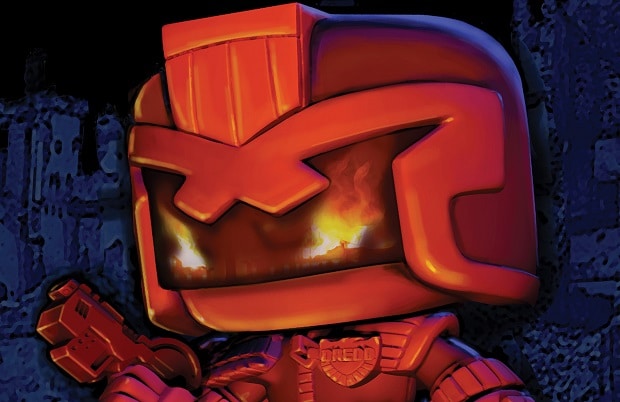 What’s cute, cuddly, and strikes fear into the hearts of villains everywhere? If you answered Baby Batman, you’re pretty close. If you answered the Funko Toy version of Judge Dredd, that would be very specific, but you’d be correct! Out this week from IDW comics, the pint-sized, bubble-headed crime fighter stars in his own one-shot comic book for fans of most ages. A work that doesn’t take itself too seriously, it’s a fun and quick read between issues of IDW’s grittier Dredd work Judge Dredd: Blessed Earth, and waiting for the Dredd TV series to finally happen.
What’s cute, cuddly, and strikes fear into the hearts of villains everywhere? If you answered Baby Batman, you’re pretty close. If you answered the Funko Toy version of Judge Dredd, that would be very specific, but you’d be correct! Out this week from IDW comics, the pint-sized, bubble-headed crime fighter stars in his own one-shot comic book for fans of most ages. A work that doesn’t take itself too seriously, it’s a fun and quick read between issues of IDW’s grittier Dredd work Judge Dredd: Blessed Earth, and waiting for the Dredd TV series to finally happen.